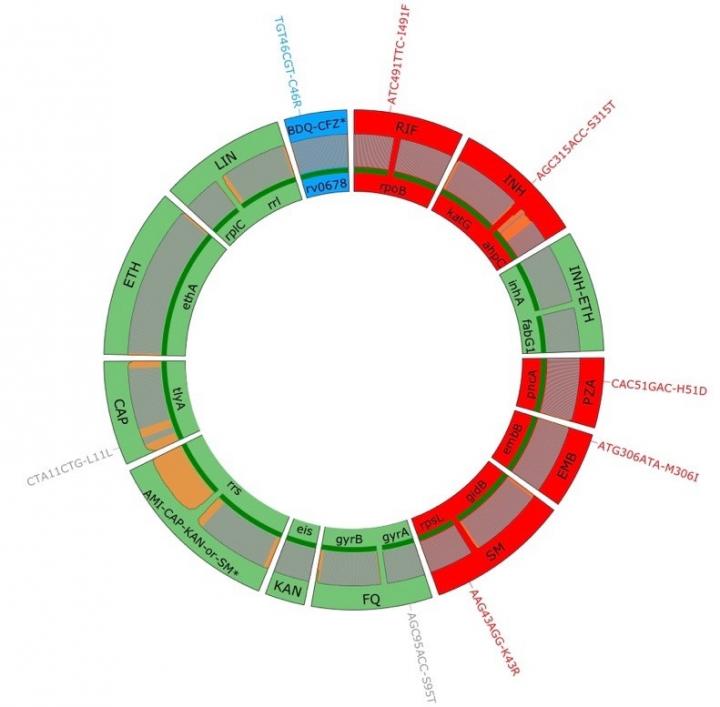Outbreak of multidrug-resistant tuberculosis undetected by standard tests

Detection of multi-resistance to antibiotics in a South African strain of tuberculosis using the Deeplex-MycTB® assay. Red and blue sections indicate confirmed or probable mutations causing resistance to first-line antibiotics and bedaquiline, respectively. Credit: Genoscreen, Lille
In over 450,000 new cases of antibiotic-resistant tuberculosis that likely appeared, only 25% were detected. A study by an international research team* co-directed by Philip Supply, a CNRS researcher at the Center of Infection and Immunity of Lille (CNRS/Inserm/Institut Pasteur de Lille/Université de Lille), has underlined this serious problem of under-detection, in South Africa in particular.
The findings, published in The Lancet Infectious Diseases, show that certain South African isolates of Mycobacterium tuberculosis (the bacterium which causes the disease) carry a specific combination of mutations which make them resistant to the two primary first-line antibiotics prescribed: rifampicine and isoniazide.
This combined resistance goes undetected by the standard tests endorsed by the World Health Organization: the gene region carrying a particular mutation causing rifampicine resistance is not included in the DNA test, and the resistance to the treatment due to this mutation is not detected in cultures.
This omission leads to unsuccessful first-line treatments in patients, increased mortality and contagion, and the development of additional antibiotic resistances. Researchers especially detected the presence of mutations probably causing decreased sensitivity to bedaquiline, the newest molecule used to treat cases of multidrug-resistant (MDR) tuberculosis. These mutations appeared immediately following its launch in the country from 2013 on.
This was discovered thanks to a new MDR screen test developed by Genoscreen** together with P. Supply. Unlike standard DNA tests, this one analyses a wide panel of target genes in the bacteria and can identify resistance to over a dozen antibiotics simultaneously. These results are obtained in as little as one to three days, compared to the weeks needed for cultures. The test will help solve the problem of under-detection of MDR tuberculosis.
It will benefit from a new algorithm for the detection of resistance mutations, the effectiveness of which has been detailed in an article published in The New England Journal of Medicine by another consortium (CRyPTIC)*** in which Dr Supply and Genoscreen took part. This study was based on an analysis of 10,000 genomes, making it one of the biggest microbial genome sequencing projects conducted to date.
###
* – National Health Laboratory Service, Dr George Mukhari Tertiary Laboratory, Pretoria, Sefako Makgatho Health Sciences University, Pretoria, and Gauteng Department of Health, Hatfield, South Africa; National Reference Laboratory, Ministry of Health, Mbabane, Swaziland; Forschungszentrum Borstel and German Center for Infection Research, Borstel Site, Borstel, Germany; Institute of Tropical Medicine and University of Antwerp, Antwerp, Belgium; Université Catholique de Louvain, Brussels, and Katholieke Universiteit Leuven, Leuven, Belgium
** – Company specialised in genomics, based at the Institut Pasteur de Lille.
Media Contact
All latest news from the category: Life Sciences and Chemistry
Articles and reports from the Life Sciences and chemistry area deal with applied and basic research into modern biology, chemistry and human medicine.
Valuable information can be found on a range of life sciences fields including bacteriology, biochemistry, bionics, bioinformatics, biophysics, biotechnology, genetics, geobotany, human biology, marine biology, microbiology, molecular biology, cellular biology, zoology, bioinorganic chemistry, microchemistry and environmental chemistry.
Newest articles

NASA: Mystery of life’s handedness deepens
The mystery of why life uses molecules with specific orientations has deepened with a NASA-funded discovery that RNA — a key molecule thought to have potentially held the instructions for…

What are the effects of historic lithium mining on water quality?
Study reveals low levels of common contaminants but high levels of other elements in waters associated with an abandoned lithium mine. Lithium ore and mining waste from a historic lithium…

Quantum-inspired design boosts efficiency of heat-to-electricity conversion
Rice engineers take unconventional route to improving thermophotovoltaic systems. Researchers at Rice University have found a new way to improve a key element of thermophotovoltaic (TPV) systems, which convert heat…



